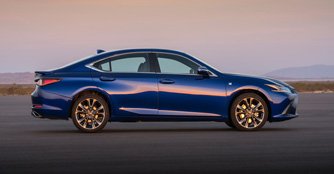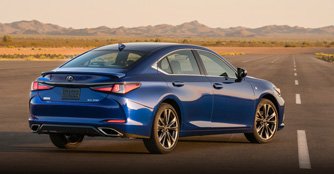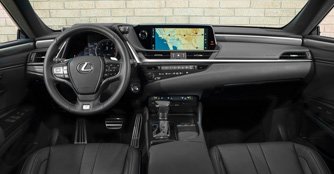The new seventh generation Lexus ES
25 Apr 2018|5,822 views
Long known for its unparalleled comfort, refinement and luxury appointments, the seventh generation ES builds on its strengths with an all new chassis that allows for a more dynamic exterior design and the introduction of the first ES F Sport.

Built on the all new Global Architecture - K (GA-K) platform, the new ES pushes the limits of design in the luxury sedan class. This ES is longer, lower and wider than before with wheels that have been pushed closer to the corners thanks to a 2.0-inch longer wheelbase and wider tracks front and rear. Its stance and proportions reflect its newfound performance capabilities and give the ES the kind of eye-catching appearance that will make owners take a second look as they walk away.
When designing the look and feel of the ES's interior, Project Chief Designer, Yasuo Kajino's team started with the Lexus Future Interior concept, which blends a driver-centric cockpit with a spacious and comfortable area for the front passenger. In the ES, the driver's focus is kept on the road ahead by placing the center display screen, instrument panel and available heads up display in a tight cluster in the driver's field of view. Front passengers, on the other hand, get a more open and spacious environment that promotes relaxation.

In addition to the boost in power, the ES350 also benefits from a new eight-speed Direct Shift automatic transmission. It uses an ultra-thin torque converter and a multi-plate lock up clutch to more efficiently transfer power to the front wheels, and has been tuned to deliver crisp, precisely timed shifts with quick responses. With a wider spread of ratios, the new eight speed is able to utilise high torque gears on the low end for quick starts and tall gearing on the high end for optimum efficiency.
Not to be outdone by its gasoline siblings, the ES300h is capable of delivering exceptional fuel efficiency, responsive performance and minimal emissions for an entry-level luxury sedan. A new, fourth generation Hybrid Drive System couples an ultra-efficient, Atkinson cycle 2.5-litre, four-cylinder gas engine with a lighter, more compact, more power dense electric motor and self-charging hybrid system. Together they deliver a combined 215bhp and a preliminary estimate of 44mpg in combined driving.

An all new engine, the 2.5-litre four-cylinder incorporates fast-burn combustion technology that makes it one of the most thermally efficient engines ever offered in a Lexus. The result is more power without increasing emissions or fuel consumption. Various methods were used to achieve such impressive results including straight intake ports, increased valve angles and laser-clad valve seats. A variable capacity oil pump, multihole injectors, VVTi-E on the intake valves and a variable cooling system also contribute to the engine's impressive heat and combustion management.
One element of the ES that hasn't been radically transformed is its dedication to safety. All versions of the seventh generation ES feature the new Lexus Safety System+ 2.0 as standard equipment. Already one of the most sophisticated systems of its kind, LSS+ 2.0 adds new features that further expand its capabilities.
One such feature is daytime bicyclist detection which is part of the comprehensive Pre-Collision System (PCS). Already designed to detect an oncoming vehicle or pedestrian, the PCS system's ability to potentially detect a bicyclist addresses a common accident scenario. PCS has also been enhanced to help better detect a pedestrian at night by increasing the radar's sensitivity and dynamic range.
Long known for its unparalleled comfort, refinement and luxury appointments, the seventh generation ES builds on its strengths with an all new chassis that allows for a more dynamic exterior design and the introduction of the first ES F Sport.

Built on the all new Global Architecture - K (GA-K) platform, the new ES pushes the limits of design in the luxury sedan class. This ES is longer, lower and wider than before with wheels that have been pushed closer to the corners thanks to a 2.0-inch longer wheelbase and wider tracks front and rear. Its stance and proportions reflect its newfound performance capabilities and give the ES the kind of eye-catching appearance that will make owners take a second look as they walk away.
When designing the look and feel of the ES's interior, Project Chief Designer, Yasuo Kajino's team started with the Lexus Future Interior concept, which blends a driver-centric cockpit with a spacious and comfortable area for the front passenger. In the ES, the driver's focus is kept on the road ahead by placing the center display screen, instrument panel and available heads up display in a tight cluster in the driver's field of view. Front passengers, on the other hand, get a more open and spacious environment that promotes relaxation.

In addition to the boost in power, the ES350 also benefits from a new eight-speed Direct Shift automatic transmission. It uses an ultra-thin torque converter and a multi-plate lock up clutch to more efficiently transfer power to the front wheels, and has been tuned to deliver crisp, precisely timed shifts with quick responses. With a wider spread of ratios, the new eight speed is able to utilise high torque gears on the low end for quick starts and tall gearing on the high end for optimum efficiency.
Not to be outdone by its gasoline siblings, the ES300h is capable of delivering exceptional fuel efficiency, responsive performance and minimal emissions for an entry-level luxury sedan. A new, fourth generation Hybrid Drive System couples an ultra-efficient, Atkinson cycle 2.5-litre, four-cylinder gas engine with a lighter, more compact, more power dense electric motor and self-charging hybrid system. Together they deliver a combined 215bhp and a preliminary estimate of 44mpg in combined driving.

An all new engine, the 2.5-litre four-cylinder incorporates fast-burn combustion technology that makes it one of the most thermally efficient engines ever offered in a Lexus. The result is more power without increasing emissions or fuel consumption. Various methods were used to achieve such impressive results including straight intake ports, increased valve angles and laser-clad valve seats. A variable capacity oil pump, multihole injectors, VVTi-E on the intake valves and a variable cooling system also contribute to the engine's impressive heat and combustion management.
One element of the ES that hasn't been radically transformed is its dedication to safety. All versions of the seventh generation ES feature the new Lexus Safety System+ 2.0 as standard equipment. Already one of the most sophisticated systems of its kind, LSS+ 2.0 adds new features that further expand its capabilities.
One such feature is daytime bicyclist detection which is part of the comprehensive Pre-Collision System (PCS). Already designed to detect an oncoming vehicle or pedestrian, the PCS system's ability to potentially detect a bicyclist addresses a common accident scenario. PCS has also been enhanced to help better detect a pedestrian at night by increasing the radar's sensitivity and dynamic range.
Latest COE Prices
August 2025 | 2nd BIDDING
NEXT TENDER: 03 Sep 2025
CAT A$104,524
CAT B$124,400
CAT C$72,190
CAT E$125,001
View Full Results Thank You For Your Subscription.




















